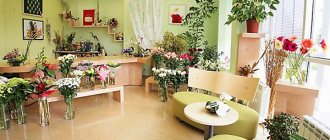Indoor plants have been used to decorate our homes since ancient times. They live in living rooms and bedrooms, children's rooms and offices. They also paid attention to the kitchen. Many housewives enjoy decorating their home with various representatives of the earth's flora. And yet, which flowers are preferable for the kitchen, how to choose the right plant and what needs to be taken into account.
The kitchen is a paradise for plants
Criteria for choosing colors for the kitchen
Today, when the shelves of flower shops are filled with all kinds of tropical exotics, choosing a plant for the kitchen is quite difficult. Not every representative of the earth's flora is able to withstand extreme kitchen conditions. Constant temperature changes, steam and grease splashes, and frequent ventilation are not good for many plants. What needs to be taken into account in order not to make a mistake when choosing indoor flowers for the kitchen?
The main selection criteria are:
- expected location of the plant
- the side facing the kitchen windows
- room dimensions
- personal preferences
- decorative value of a flower
Let's take a closer look at each factor to make the right choice.
The windowsill is a place where flowers in the kitchen do not disturb the housewife and feel great.
When determining a place for a flower, the first thing we pay attention to is the window sill. It’s great if it’s wide and you can place voluminous plants on it. In addition, this is the only place where flowers in the kitchen do not interfere with the housewife’s work and feel great. In addition, near the window they receive enough light for their proper development.
Depending on the side the windows face, light-loving or shade-loving plant species are selected.
Obviously, the dimensions of the room affect the number and size of flowers. It is unlikely that you will be able to place a tall ficus or Dieffenbachia, which loves space, in a small kitchen.
Personal preferences are important only for the hostess. When choosing a flower, she wants to receive both aesthetic and spiritual pleasure from being next to it.
Decorative value is related to the style of the interior. So, a delicate and touching violet looks great on the dining table, and a modest succulent is also suitable for decorating an open shelf.
Violet is great for the kitchen
Care
Regardless of the type, any ornamental plants require sufficient light, and in cases where this is not possible, additional lighting must be installed. For the kitchen, it is better to choose plants with large leaves, as there is oil in the air, so it will be easier to remove it by wiping the leaves.
Ficus benjamina is a moisture-loving plant that requires frequent watering and soil replenishment. Afraid of drafts, should be placed away from the window.
Chlorophytum - the leaves are delicate, so spraying with a spray bottle is sufficient. It is not affected by temperature changes in the room.
Violet - does not tolerate direct sunlight. For irrigation, water must be poured into the pan.
Begonia loves high air humidity in summer and winter, so the plant should be placed on a tray with water. Does not withstand overwatering, as well as dry soil.
Flowers can purify the air, add coziness and make the kitchen feel lived-in. Therefore, knowing the rules for choosing and decorating the interior with plants, which were listed above, you can decorate the room, and most importantly, it will not be difficult to do.
Conditions of detention
In order for the flowers in the kitchen to feel cozy and healthy, it is necessary to provide them with proper care. First of all, it is worth deciding where you can place plants, and where it is strictly not recommended.
- You cannot place flowers next to the sink. When washing dishes, cleaning products containing chemicals are used. Splashes fall on the plant, and it can get burned or die.
- You can't keep flowers near the stove. When cooking food, a greasy coating inevitably accumulates on them, which interferes with the normal respiration of the plant. It begins to suffocate, loses its beautiful appearance, gets sick and dies.
- The best place to place plants in the kitchen is a window sill, hanging shelves and flowerpots.
- It is possible to place flowers on the floor if the size of the kitchen allows this.
Important! When keeping flowers on a windowsill, try to protect them from drafts. When ventilating the room, take your pets to another room.
Plants in the kitchen need to be watered more often and wiped regularly.
If you decide to put a flower on the refrigerator or top shelf, get ready for the fact that it will need to be watered more often and wiped regularly. Hot air accumulates at the top, so the plant requires natural cooling and maintaining normal humidity.
Kitchen plants: features
House flowers, which can be placed on the windowsill or in the corners of the room, are especially important in winter, when it is cloudy outside, and the sight of blooming greenery can lift the spirits of all residents. They also have properties that:
- improve the microclimate;
- absorb carbon dioxide and harmful substances released when the stove burns;
- saturate the room with clean air.
Due to their specific conditions, tropical plants and succulents best tolerate the kitchen microclimate, as they do not require special care.
Types of indoor plants for the kitchen
Now let’s go to the store and see what they offer us, and decide which flowers can be kept in the kitchen, taking into account the criteria described above.
If your kitchen windows face southwest, west or east, you can afford to place such demanding flowers as encyclia, mentholia, and phalaenopsis from the orchid family on the windowsill. This arrangement will also be well received by various types of succulents, including the beloved spurge. Azalea and passionflower, crotons and cacti, agave and cyclamen will take root here.
Demanding flowers from the Orchid family look great on the kitchen window
For north and northeast windows, choose plants that can tolerate shade. Dracaena, sansevieria, bamboo, various types of monstera, dieffenbachia, and aglaonema grow well in this direction.
A frequent guest of our kitchens, chlorophytum not only feels great in conditions of temperature changes, but also serves as a living filter. Among indoor flowers, it is known as an excellent odor trap and air purifier.
Fruit-bearing plant species fit elegantly into the kitchen interior. Decorative coffee tree, dwarf citrus fruits, and decorative peppers look impressive and organically complement the overall mood of the kitchen.
Owners of small kitchens, where air humidity is often high, should pay attention to plants that love high humidity. These include species such as arrowroot, calathea, and balsam.
These wonderful miniature citrus trees make your home look like a piece of paradise.
You have a narrow window sill and no free surface for arranging indoor flowers, then choose hanging varieties. This is the well-known tradescantia, ivy, and scindapsus. They can be beautifully placed on the walls, either in separate, hanging pots, or freely curled around the entire perimeter of the kitchen.
For a large kitchen, be sure to look for two or three plants for floor placement. Yucca, hibiscus, dracaena, ficus will allow you to create a small green oasis in the kitchen in the dining area. They will give the room freshness and a special, natural charm.
How to choose
We do not recommend choosing expensive exotic flowers for the kitchen. Such specimens are most often very demanding in terms of compliance with all the parameters of their content. The slightest change in temperature, draft or poor lighting - a bright, beautiful flower will wither and may die.
As an option, expensive tropical plants can be placed in a combined kitchen-dining room, placing them in the sitting or dining area, away from work surfaces.
In the video - how to choose the necessary flowers:
That is why we advise you to choose unpretentious options for indoor plants that are suitable for the kitchen.
Blooming
The most frequent guests in the kitchen: begonia, geranium, primrose. These are beautiful flowers, the flowering period of which is quite long, but at the same time they are unpretentious and easy to care for. Perhaps this is the best option for the kitchen.
Blooming flowers for the kitchen
Cyclamen, azalea, violet, and Kalanchoe are well suited for the kitchen. Impatiens tolerate high humidity well. In a large kitchen you can place a Chinese rose.
Feng Shui teachings recommend placing a pot of geranium in the kitchen - it copes well with negative energy and fatigue.
With original leaves
Such ornamental plants as croton with multi-colored leaves and shefflera look good. The beautiful dracaena is tolerant to elevated temperatures. If the dracaena is not transplanted into a spacious pot, it will not grow too large. You can find out which countertop for the kitchen is better to choose by following the link.
This is what flowers with original leaves look like for the kitchen
It is good to plant bamboo in the kitchen. It will look especially interesting as a living wall between the cooking area and the dining room or the kitchen and the living room. You can place pots of arrowroot or calathea in the sink area - they are not afraid if a few drops fall on the leaves.
Sansevieria is a plant that is almost impossible to “kill” with poor care. Without watering, “Mother-in-law’s tongue,” as it is popularly called, can stand for several months.
Fruit
Small plants that not only bloom, but also bear fruit, are more appropriate in the kitchen than anywhere else. This is a decorative pepper, a miniature coffee tree. In a large kitchen you can place a lemon or orange tree.
This is what fruit plants for the kitchen might look like
Many housewives grow decorative tomatoes or cucumbers on their kitchen windowsills.
You can find out about design ideas for the kitchen here.
Unpretentious
Drafts in the kitchen are common, but not all indoor plants can cope with them. Begonia, zebrina, hypoestes, scindapsus are not afraid of drafts and can be safely used to decorate the kitchen.
Chlorophytum is an unpretentious and one of the hardiest indoor plants. This cute plant, which looks like overgrown grass, doesn’t mind drought (if you suddenly forget to water), poor lighting, or temperature changes.
The video shows various unpretentious home flowers:
Succulents
If your kitchen is sunny and warm, you can place succulent plants. These are all kinds of cacti, agave, aloe, spathiphyllum, crassula. Such plants can be grown not only in our usual flowerpots, but also to create an interesting composition in an aquarium or in small transparent vessels. For greater decorativeness, you can consider painting on glass with stained glass paints.
Some succulent lovers even manage to grow entire pictures of cacti, spathiphyllums or agaves.
Floor-standing
Suitable for a large, spacious kitchen. These are primarily miniature trees and palms: yucca, dracaena, orange, lemon, Chinese tree. A frequent guest in the house is ficus. And, of course, the beautiful Monstera or Dieffenbachia, which will delight you with beautiful and unusual leaves.
Yucca flowers for the kitchen
If space allows, you can create a small corner - a winter garden, which will be a beautiful addition to the interior.
You can find out about setting the holiday table at home here.
Ampelous
These are all kinds of climbing plants. The most frequent guests at the forges are tradescantia, chlorophytum, passionflower, ivy, varieties of vines, etc. It is worth noting that hanging plants are mostly unpretentious, but you should not place them near the cooking zone - greasy fumes settling on the leaves can very quickly destroy the plant.
Climbing plants for the kitchen
It is worth knowing that if the leaves of your Tradescantia or ivy in the kitchen begin to dry out during normal watering, this may be a sign of increased danger. This is how plants signal that the level of harmful radiation from appliances and furniture is going off scale and becoming dangerous to humans.
Vegetable garden in the kitchen
Many housewives grow herbs, spices, lettuce and other greens instead of indoor plants. By planting a vegetable garden on the windowsill in this way in the form of green onions, parsley or basil, you can not only decorate the kitchen, but also provide yourself with greens all year round.
This is what a kitchen garden looks like
Healthy and tasty
Many housewives replace decorative flowers in the kitchen with healthy and tasty seasonings. Growing greens on a windowsill has been practiced for a long time and has many advantages. Using the usual dill, parsley, basil, lemon balm, mint, you can create a wonderful green corner that will serve as both a decoration and a home mini-garden. The arrows of green onions and lacy leaves of parsley look no less decorative than the variegated and carved leaves of tropical exotics. In addition, you will have environmentally friendly and fresh greens at hand for your dishes.
Spicy herbs that can be grown on the kitchen windowsill
Interesting ideas
When decorating a kitchen with flowers, you want to get a complete composition that organically complements the interior of the room. What do designers offer us?
For an interior designed in a minimalist style, with straight lines and subdued colors, choose the same plants. Aspidistra, dracaena, calathea, fatsia will ideally support the design of the room. Well-chosen flowerpots and pots will help enhance the effect of the presence of green beauties. Give preference to containers that match the color of the set or, conversely, choose bright pots that contrast with the general mood.
All types of hanging plants are suitable for a kitchen designed in a French, romantic style. Gracefully hanging from the walls, they will maintain the airy character of the room, complementing it with natural beauty. For such kitchens, buy ivy, pelley, fern, streptocarpus, nephrolepis.
For high-tech or techno, choose succulents. The original liptos, nicknamed "living stones", the humble aloe vera, "mother-in-law's tongue" and all kinds of cacti will look great against the backdrop of shining metal and glass.
Mini florarium is an excellent solution for the kitchen
In a rustic interior, geranium or violet will be a living addition. Traditional kitchen plants, they will unobtrusively support the comfort and warmth of the family hearth, pleasing the eye with bright colors.
In addition to combining with style, designers use plants to zone the kitchen space. This solution is especially relevant for large premises. By placing tall ficus, monstera, and bamboo on the floor, you can separate the dining area from the working area with a beautiful hedge. You can decorate both the table and the hanging shelves above it with flowers. In such a green corner, the dishes will be tastier and the communication will be more pleasant.
If the kitchen is equipped with a bar counter, try setting up a mini-florarium on it. This unusual technique involves placing plants in an aquarium. Round or rectangular, filled with gravel and plants, it will not take up much space and will easily turn into a stylish decorative element.
As you can see, despite the steam, heat and fumes, the kitchen is quite suitable for keeping plants. A competent choice of species, correct location and compliance with recommendations for caring for indoor flowers will allow you to create a small oasis of wildlife in the kitchen. Luxurious and modest, variegated and monochromatic, plants are sure to give a lot of positive emotions to both you and your household.











